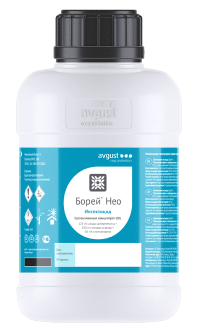
Борей Нео
Alpha-cypermethrin 125 g/l, imidacloprid 100 g/l and clothianidin 50 g/l Suspension concentrate

Alpha-cypermethrin 125 g/l, imidacloprid 100 g/l and clothianidin 50 g/l Suspension concentrate
| The name of the plant | The name of the harmful organism | Consumption rate |
| Wheat | Aphid thrips and fleas | 0,1 – 0,2л/га |
| Corn | Cereal flies, aphids, brown fleas | 0,1 – 0,2л/га |
| Rapeseed | Cross-shaped flea beetles, wasps, flower beetles | 0,08 – 0,1л/га |
| Soybean crop | Aphid, acacia (bean) moth, cotton bollworm, soybean moth, meadow moth, thrips | 0,1 – 0,2л/га |
| Peas | pea soup, pea juice | 0,1 – 0,2л/га |
| potatoes, tomatoes in open ground | Colorado beetle | 0,1 – 0,2л/га |
| Cabbage | Aphid thrips, fleas and moths | 0,1 – 0,2л/га |
| Grapes | Leaf moth | 0,1 – 0,2л/га |
| Pear, peach | Brown marble fleas | 0,1 – 0,2л/га |
Drug:
A three-pronged strike on pests!
due to the unique combination of three active substances belonging to two different chemical classes and differing in their mechanism of action, it provides high speed of action and long-term protection.
reliable control of a complex of pests of grain and other crops, designed to eliminate hidden insects.
Maintaining high insecticidal activity in a wide range of temperature and air humidity.
The possibility of using aviation against pests of wheat crops, locusts and conifers.
Recommendations for use:
against seedling pests, wheat, beet fleas and other pests during the growing season of crops, when pests appear in large numbers in the field. In the treatment of areas inhabited by locusts, spraying is carried out during the development of larvae.
Consumption of liquid used:
When spraying seedlings against pests – 100 – 200 l/ha, against wheat, barley and pea pests during the growing season – 200 – 300, against other crops and plant objects – 200 – 400, in pomegranate gardens – 600 – 1200, stone fruits – 500 – 1000, in vineyards – 500 – 1000,